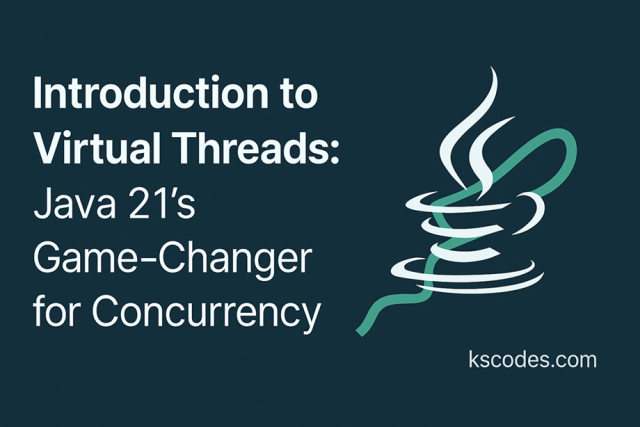With Java 21, Virtual Threads are no longer just an experimental idea — they are here to revolutionize how we handle concurrency in Java. Lets see how Virtual Threads in Java 21 can be a game changer for concurrency.

🔍 What Is Concurrency in Java?
Concurrency means doing multiple things at once.
In Java:
- This is done using threads — units of work that can run independently.
- Traditionally, Java has relied on platform threads, which are managed by the Operating System (OS).
A typical server application uses threads to:
- Handle each HTTP request
- Call external APIs or databases
- Process background jobs
😩 The Pain Points of Platform Threads
Platform threads have been around for years, but they come with some big limitations:
1. 📦 Heavyweight
- Each thread uses around 1MB of memory stack.
- Systems can’t handle more than a few thousand threads efficiently.
2. ⛔ Blocking Wastes Resources
- If a thread waits (e.g., on I/O or a DB call), it just sits there doing nothing but still consuming resources.
3. 💥 Thread Starvation
- You can run out of threads under high load.
- This leads to latency spikes, dropped requests, or crashes.
💡 Enter: Virtual Threads in Java 21
✅ What Are Virtual Threads?
- Introduced as a preview feature in Java 21 under Project Loom
- A virtual thread is not backed by an OS thread directly.
- Managed by the Java Virtual Machine (JVM)
- Scheduled in user space, not by the OS
🔑 Key Properties:
| Feature | Virtual Threads |
|---|---|
| Lightweight | Only needs a few KB of memory |
| Cheap to create | You can spawn millions of them |
| Suspendable | Can pause when waiting (I/O) without blocking a platform thread |
| Fully interoperable | Works with existing Java APIs (Thread, Executor) |
🔧 How to Use Virtual Threads in Java
🧵 Option 1: Launching a Virtual Thread
|
1 2 3 4 5 6 |
Thread.startVirtualThread(() -> { System.out.println("Running in a virtual thread!"); }); |
🧵 Option 2: Using Virtual Thread Executor
|
1 2 3 4 5 6 7 8 9 10 |
ExecutorService executor = Executors.newVirtualThreadPerTaskExecutor(); executor.submit(() -> { // Your background task here System.out.println("Task running in virtual thread"); }); executor.shutdown(); |
✅ No new APIs to learn — it works just like regular threads!
🧪 Sample Program – Scaling to 100,000 Threads
|
1 2 3 4 5 6 7 8 9 10 11 12 13 14 |
ExecutorService executor = Executors.newVirtualThreadPerTaskExecutor(); for (int i = 0; i < 100000; i++) { executor.submit(() -> { try { Thread.sleep(1000); // Simulate delay System.out.println("Task completed by: " + Thread.currentThread()); } catch (InterruptedException e) { Thread.currentThread().interrupt(); } }); } executor.shutdown(); |
💥 This would crash with platform threads — but runs smoothly with virtual threads!
🔍 How It Works Internally
- Virtual threads are mounted on platform threads only when running.
- If they hit a blocking operation (like sleep or I/O), they are unmounted.
- Other virtual threads can reuse the same platform thread.
This makes virtual threads non-blocking, efficient, and scalable.
🔄 Comparison: Platform Threads vs Virtual Threads
| Feature | Platform Threads | Virtual Threads |
|---|---|---|
| Memory Usage | ~1MB | ~Few KB |
| Managed By | OS | JVM |
| Number of Threads | Thousands | Millions |
| Blocking Behavior | Blocks OS Thread | Does not block |
| Startup Time | High | Near-instant |
| Use Case | Parallelism | Concurrency (I/O-heavy) |
🎯 Best Use Cases for Virtual Threads
- 🌐 High-concurrency servers (e.g., REST APIs, chat apps)
- 📞 Microservices making lots of remote calls
- 🧰 Task schedulers and job queues
- 🗃️ Applications interacting with databases or external APIs
⚠️ Limitations and Considerations
- 🔬 Still a preview feature in Java 21 (enable with
--enable-preview) - 🧪 Some blocking APIs (like native I/O) may not yet be optimized for virtual threads
- 🔧 Debugging tools and thread-local usage may behave differently
🛠️ How to Compile and Run with Virtual Threads
Since it’s a preview feature:
|
1 2 3 4 |
javac --enable-preview --release 21 VirtualThreadDemo.java java --enable-preview VirtualThreadDemo |
🧵 Virtual Threads vs Reactive Programming
| Feature | Virtual Threads | Reactive (e.g., Project Reactor) |
|---|---|---|
| Complexity | Very low (just use Thread) | High (requires learning reactive APIs) |
| Code Style | Imperative, familiar | Declarative, callback-based |
| Debuggable | Easy to debug | Complex call stacks |
| Ecosystem Support | Works with existing code | Requires reactive-aware libs |
👉 Virtual threads allow traditional blocking-style code with non-blocking performance.
🧾 Final Thoughts
🎉 With Virtual Threads, Java makes concurrency simpler and scalable — no need for complex thread pools or callback chains. You write code just like you always have, and the JVM handles the efficiency for you.
Java 21 + Virtual Threads = Concurrency for Humans
Reference : Virtual Threads